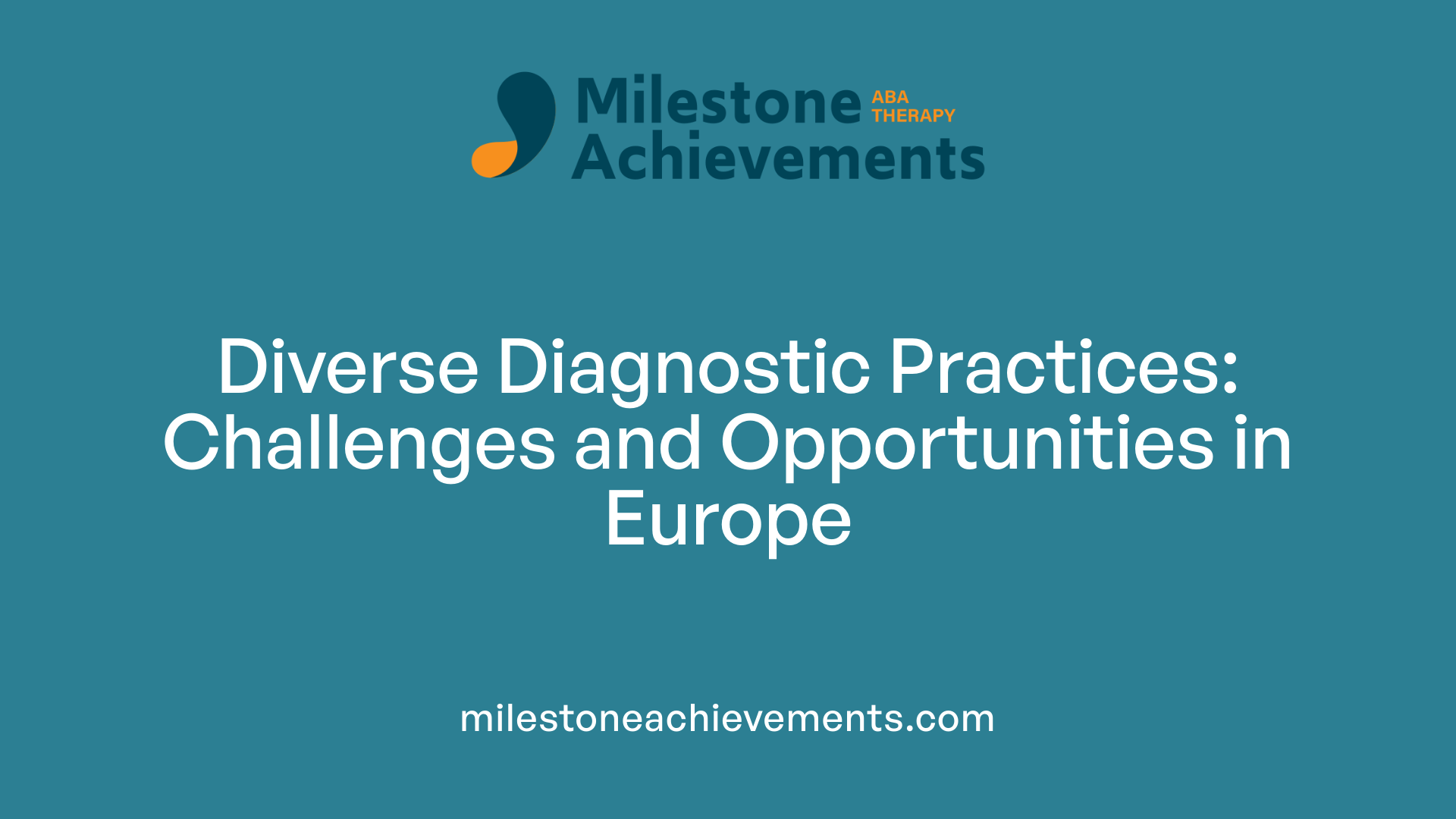
Autism Statistics in Europe
Understanding Autism in Europe: Trends, Challenges, and Progress
An In-Depth Look into Autism Across European Nations
Autism Spectrum Disorder (ASD) presents a diverse and complex public health challenge across Europe. With estimates suggesting that approximately 1 in 100 people are affected, robust data reveal significant variation in prevalence rates, diagnostic practices, and support systems. This article explores the epidemiological landscape of autism in Europe, analyzing how differences in healthcare infrastructure, diagnostic criteria, and socio-cultural attitudes shape the understanding and management of autism spectrum disorder on the continent.
Prevalence Rates and Geographic Variability

What are the autism prevalence rates in European countries?
In Europe, autism spectrum disorder (ASD) prevalence varies widely from country to country. Based on recent studies, the overall prevalence among children aged 5–18 years is approximately 1%, but some countries report much higher or lower rates due to differences in research methods.
For example, in Italy, specifically Pisa, the prevalence among primary school children is estimated at around 0.8%, whereas in Romania, it can be as high as 14.3%. These differences highlight the significant geographic variability within the continent. Overall, it is estimated that about 1 in 100 people in Europe are affected by autism.
The prevalence rates are also influenced by diagnostic practices and awareness levels. Countries like the UK and Scandinavian nations tend to have more comprehensive data, partly because of organized support systems and diagnostic criteria. In contrast, Eastern and Southern European countries may underreport due to less structured diagnostic procedures.
Recent research estimates that broad ASD prevalence could reach between 30 and 63 per 10,000 people. While the rates for 'classical autism' are lower, ranging from 3.3 to 16 per 10,000, including all ASD forms significantly raises these numbers. This trend reflects increasing awareness and changing diagnostic criteria over the past decades.
Impact of methodology on prevalence rates
Differences in research methods, diagnostic criteria (such as DSM-5 versus ICD-11), and data collection significantly influence reported rates. For instance, register-based studies tend to yield lower estimates (around 0.8%) compared to population surveys (about 1.4%). Such variability complicates efforts to determine the actual prevalence.
Studies also face challenges like stigma, cultural differences, and inconsistencies in diagnosis, which can lead to underreporting in some regions and overdiagnosis in others. Nordic countries often have more accurate estimates due to their systematic support and data collection, contrasting with less organized systems elsewhere.
In summary, while approximately 1% of Europeans are affected by autism, actual prevalence may be higher, and understanding the true scope requires addressing methodological differences and improving diagnostic consistency across countries.
Diagnostic Practices and Healthcare Infrastructure

How do autism diagnosis practices differ across European nations?
Diagnosis practices for autism spectrum disorder (ASD) vary considerably across Europe. These differences stem from varying healthcare systems, diagnostic criteria, and levels of awareness among health professionals and the public. As a result, reported prevalence rates fluctuate between countries, making direct comparisons challenging.
In some countries like Germany and Spain, diagnostic pathways tend to be more structured and accessible. These nations often have well-established programs that facilitate earlier and more consistent diagnoses. On the other hand, countries such as France and the United Kingdom face significant hurdles, including lengthy wait times, limited service availability, and complex eligibility requirements.
Access to diagnosis and subsequent support services is another area of variation. Many individuals experience delays exceeding six months to receive an official diagnosis. Such delays often occur because of a shortage of specialists, lack of coordination among healthcare providers, and insufficient training on autism in some regions.
Early detection remains vital for improving outcomes, yet it is inconsistent across Europe. While some nations have implemented screening programs in schools and clinics, others lack standardized early detection initiatives, especially for adults seeking diagnosis.
Challenges are especially prominent in adult diagnosis, with many adults remaining undiagnosed or facing barriers to accessing services. This situation reflects resource limitations, unfamiliarity with adult autism, and discrepancies in healthcare policies.
How do healthcare systems influence autism diagnostics?
The architecture of healthcare systems significantly impacts the efficiency and accessibility of autism diagnosis services. Nordic countries generally have comprehensive healthcare coverage and integrated systems that support timely diagnoses. Conversely, Eastern and Southern European countries often exhibit fragmented services with notable gaps, resulting in longer wait times and lower diagnosis rates.
Overall, there is an urgent need for harmonized policies and improved infrastructure. Greater awareness, professional training, and resource allocation are essential to ensure that all individuals receive equitable and prompt assessments, regardless of their country of residence.
Factors Influencing Diagnosis Rates

What factors influence autism diagnosis rates in Europe?
Several aspects affect how autism spectrum disorder (ASD) is diagnosed across different European countries. Variations in diagnostic criteria and practices play a significant role, leading to disparities in reported prevalence. Some countries adopt more comprehensive diagnostic tools and protocols, which can result in higher detection rates, while others may have limited resources that cause underdiagnosis.
Increased public awareness and improved access to healthcare services have also contributed to more children and adults being identified with autism recently. With better understanding and advocacy, more individuals are seeking assessments, which inflates reported prevalence figures.
Cultural attitudes influence how societies perceive autism. In some regions, stigma or lack of awareness might prevent families from pursuing evaluations, resulting in lower reported rates. Conversely, regions with proactive healthcare systems and societal acceptance tend to diagnose autism more frequently.
Biologically, factors such as parental age at conception, maternal health during pregnancy, environmental exposures, and perinatal conditions can influence the true prevalence of autism.
These biological variables add to the complexity, as they may increase autism risk in certain populations. When combined with social and healthcare factors, they produce diverse diagnosis rates across Europe.
In summary, the influence on autism diagnosis rates stems from a blend of diagnostic standards, societal attitudes, healthcare accessibility, and biological risk factors. This interplay explains the wide differences in reported autism prevalence from country to country in Europe.
| Factor | Impact | Additional Notes |
|---|---|---|
| Diagnostic criteria | Changes in standards can increase or decrease reported cases | DSM-5 versus ICD-11 differences |
| Awareness and advocacy | Higher awareness leads to more diagnoses | Variation in public health campaigns |
| Healthcare access | Poor access results in underdiagnosis | Availability of specialists and diagnostic tools |
| Cultural attitudes | Influence willingness to seek evaluation | Stigma or acceptance levels |
| Biological risk factors | Actual prevalence may vary based on genetics and environment | Parental age, prenatal factors |
By understanding these variables, we can better interpret the differences in autism prevalence data across Europe and recognize the importance of improving diagnostic practices and access in underserved regions.
Regional Disparities in Prevalence and Support Services

Are there regional differences in autism prevalence and support services across Europe?
Yes, significant variations exist across different European regions regarding autism prevalence and the availability of support services.
Prevalence rates of autism in Europe vary widely. For example, register-based studies report rates as low as 0.3% in parts of Poland, while Romania shows rates as high as 14.3%. When considering all forms of autism spectrum disorder (ASD), estimated prevalence can range from 30 to 63 per 10,000 people, reflecting substantial regional differences.
Several factors influence these disparities. Diagnostic criteria and methodologies differ, with some countries using DSM-5 and others using ICD-11, leading to inconsistent diagnosis and reporting. Increased awareness, cultural attitudes, and stigma also play roles; countries with strong advocacy and awareness, like the UK and Nordic nations, tend to report higher prevalence due to better detection.
Support infrastructure varies significantly across Europe. Northern and Western European nations generally provide more comprehensive and accessible services. Countries such as Sweden and Norway have well-developed support systems that help individuals with autism access education, employment, and healthcare.
In contrast, eastern and southern European countries often face resource shortages and service gaps. Longer waiting times, limited specialized support, and underdeveloped policies mean many autistic individuals in these regions have less access to essential services. Many autistic people with high support needs remain out of employment, education, or training, especially those living in institutions or unsupported families.
This regional divide highlights the importance of policy harmonization and infrastructure development. Strengthening support services across all regions, increasing awareness campaigns, and reducing societal stigmas are crucial steps to ensure equitable access. Addressing these disparities will help improve life's quality and opportunities for autistic individuals throughout Europe.
| Region | Prevalence Estimates (per 10,000) | Support Infrastructure | Notable Challenges |
|---|---|---|---|
| Nordic Countries | 15-16 | Extensive, accessible, early intervention programs | Ensuring continued funding and inclusivity |
| Western Europe | 10-14 | Strong support systems, inclusive education | Maintaining quality standards |
| Eastern Europe | 3-7 | Limited services, longer wait times | Underreporting, resource scarcity |
| Southern Europe | 4-8 | Emerging services, inconsistent support levels | Stigma, insufficient infrastructure |
In summary, regional differences significantly impact autism prevalence data and the support available. Addressing these gaps requires coordinated policies, resource allocation, and community engagement to foster equitable support for all autistic individuals across Europe.
Research, Policy, and the State of Autism in Europe
What is the current state of autism research and understanding in Europe?
Autism research in Europe is making significant progress through initiatives like EU-AIMS (Autism—a multi-centre European initiative for research, care, and transformation) and the subsequent AIMS-2-TRIALS. These large-scale projects focus on identifying causes of autism, developing new interventions, and applying research findings to clinical practice.
Alongside research initiatives, many national and European programs aim to improve support systems, education, and employment opportunities for autistic individuals. Community involvement and advocacy play a vital role, with organizations such as Autism-Europe representing 38 countries. They work to raise awareness, promote the rights of autistic individuals, and influence policies aligned with the UN Convention on the Rights of Persons with Disabilities.
However, despite these efforts, challenges such as limited service access, long waiting periods, and disparities between countries like the UK and Poland still hinder progress. Many autistic individuals with high support needs are not reflected in employment or education statistics, as they often live in support settings or families. Overall, Europe's approach integrates research, policy advocacy, and community engagement to foster better understanding and support, though there are still gaps to address in equitable service delivery and inclusion.
Policies and Rights Frameworks for Autistic Individuals
What are the policies and support frameworks for autistic individuals in Europe?
European countries have established a variety of policies and support structures aimed at enhancing the quality of life for autistic individuals. Many nations implement rights-based approaches that promote inclusion, access to education, healthcare, and social services.
Most Member States have adopted national disability strategies aligned with the United Nations Convention on the Rights of Persons with Disabilities (CRPD). These strategies focus on promoting equal rights, reducing stigma, and providing tailored support.
However, there is no unified autism-specific policy at the European Union level. Advocacy groups such as Autism-Europe have called for more comprehensive and harmonized strategies across member states.
Policy implementation varies significantly between countries. For example, the UK, France, and Spain have dedicated autism strategies, offering targeted programs and resources. Conversely, some countries like Poland lack specific legislation focused solely on autism.
Access to essential services such as therapy, educational support, and healthcare remains inconsistent across the continent. Many autistic individuals face long wait times, limited availability of services, and affordability issues, which hinder their full participation in society.
European efforts emphasize raising awareness, fostering inclusive practices, and supporting families. Nevertheless, ongoing work is necessary to standardize policies, improve service delivery, and ensure that the rights of all autistic people are fully protected and promoted.
Towards Greater Equity and Understanding
While significant strides have been made in understanding, diagnosing, and supporting autistic individuals across Europe, disparities in prevalence data, healthcare access, and support services highlight the ongoing challenges. Enhancing harmonization of diagnostic practices, expanding resources for early detection, and implementing comprehensive, inclusive policies are essential steps forward. Continued research, advocacy, and community engagement are crucial to building a more equitable and supportive environment for autistic people throughout Europe, ensuring their rights, needs, and potential are fully recognized and met.
References
- Prevalence rate of autism - Autism Europe
- The Prevalence of Autism Spectrum Disorder in Europe | IntechOpen
- [PDF] Some elements about the prevalence of Autism Spectrum Disorders ...
- Are Autism Rates Lower in Europe Than in the U.S.
- [PDF] WAAD-2020_Manifesto_EN.pdf - Autism Europe
- The Prevalence of Autism Spectrum Disorder in Europe | IntechOpen
- Prevalence rate of autism - Autism Europe
- The global prevalence of autism spectrum disorder: A three-level ...


Partner with us on your child's journey
Milestone Achievements offers evidence-based ABA therapy to help children with autism reach their full potential. Together we’ll set meaningful goals and celebrate progress every step of the way.
Start ABA Services Today





